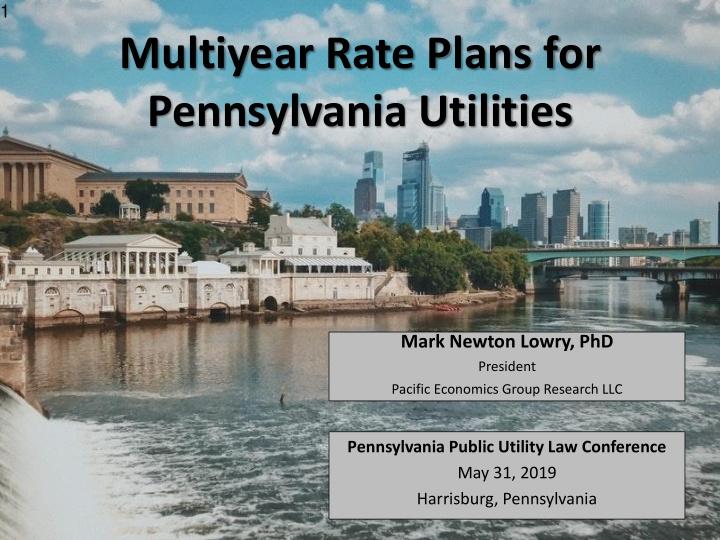



1 Multiyear Rate Plans for Pennsylvania Utilities Mark Newton Lowry, PhD President Pacific Economics Group Research LLC Pennsylvania Public Utility Law Conference May 31, 2019 Harrisburg, Pennsylvania
2 Introduction Act 58 of 2018 permits Pennsylvania’s Public Utility Commission to approve alternative rate regulation mechanisms (“ Altreg ”) The Commission is specifically authorized to permit – Revenue decoupling – Performance- based rates (“PBR”) – Multiyear rate plans (“MRPs”) This presentation provides an overview of PBR and a closer look at multiyear rate plans
3 What is PBR? PBR: Regulation designed to improve utility performance with stronger incentives 4 well-established approaches Targeted Performance Incentive Mechanisms (“PIMs”) Multiyear Rate Plans (“MRPs”) Revenue Decoupling Special Incentives (e.g. cost trackers and capitalized expenses) to Use Underutilized Inputs
4 PBR Options PBR tools are often used in combination MRPs Targeted Revenue PIMs Decoupling Incentivizing Cost Trackers
5 Multiyear Rate Plans Key Components • Reduced rate case frequency (e.g., 4 or 5 year cycle) • Attrition relief mechanism (“ARM”) automatically escalates rates or revenue but is not linked to utility’s actual costs • Trackers for some costs (e.g., energy, conservation) • PIMs link revenue to reliability and customer service quality Optional Components • Revenue decoupling • Additional PIMs (e.g., demand-side management) • Integrated resource and distribution system planning • Earnings sharing and off-ramp mechanisms • Marketing flexibility (e.g., optional rates and services)
6 Case Study: Central Maine Power (CMP) Attrition Relief Mechanism: growth Rates = growth GDPPI – X (X=1%) Capital Cost Tracker: Automated metering infrastructure Earning Sharing: Asymmetric sharing of surplus earnings Plan term: 5 years (2009-13) Service Quality: Multi-indicator penalty mechanism Marketing Flexibility: Light-handed regulation of optional targeted rate schedules and rate discounts Reference: Maine Public Utilities Commission, “ARP 2008 Settlement,” June 2008
7 MRP Precedents: United States MRPs are a common form of Altreg in U.S. Popular for vertically integrated electric utilities (e.g., Hawaii) Renewed popularity for power distributors (e.g., New England)
8 MRP Precedents: Canada MRPs are the norm for Canadian gas & electric power distributors Impetus has come mainly from policymakers
9 MRP Pros and Cons Advantages • Fewer, less overlapping rate cases free resources for other uses • Stronger cost containment incentives encourage better performance • May facilitate light-handed regulation of optional rates and services • Benefits can be shared with customers • Likely component of “utility of the future” regulation Disadvantages • Consumer groups wary of automatic rate increases • Utility risk may increase • ARM design methods can be complex and controversial • Intervenors may lack resources and skills to protect consumers • Difficult to accommodate capital cost surges
10 ARM Design Options ARM design is biggest issue in most MRP proceedings Several well-established approaches ▪ Indexing growth Revenue = Inflation – X + growth Customers e.g., ▪ Forecasting ▪ Hybrid X factor controversies in US and Canada
11 Challenge: Accelerated Modernization R with accelerated modernization e v without e n u e time Agreeing on ARMs for rapidly modernizing utilities can be difficult. If ARM is indexed, utilities may seek supplemental capital revenue Integrated distribution system planning can aid recognition of capex requirements
12 Multifactor Productivity Trend of CMP Under MRPs MRPs have improved utility performance But some plan provisions (e.g., earnings sharing & capital cost trackers) weaken incentives
13 Appendix
14 Marketing Flexibility MRPs can afford utilities more marketing flexibility by reducing rate case frequency and opportunities for cross-subsidization e.g., “Streamlined regulation” of optional tariffs and services Special contracts Green power packages (utility scale and distributed) Energy transformation services (e.g., EV charging, heat pump leasing) Reliability-differentiated services Other smart-grid-enabled services MRPs have been popular in utility industries facing competition, technical change, and complex, changing demand
15 Encouraging Use of Underutilized Inputs Track costs of underutilized inputs o Demand-side management programs o Purchased power o Premium payments for DG power at right times and locations o Pilot programs Bolster incentives to incur these costs by – Capitalizing them – adding an ROE premium – awarding utility a share of them
16 Bibliography Lowry, M. N., and Makos, M., “Regulatory Reform for the Hawaiian Electric Companies,” Public Utilities Commission of the State of Hawaii, Docket 2018 -0088, filed January 4, 2019. Lowry, M.N., Makos, M., Deason, J., and Schwartz, L., 2017. “State Performance - Based Regulation Using Multiyear Rate Plans for U.S. Electric Utilities,” for Lawrence Berkeley National Laboratory, Grid Modernization Laboratory Consortium, U.S. Department of Energy, July 2017. Lowry, M. N., and Woolf, T., 2016. “Performance -Based Regulation in a High Distributed Energy Resources Future ,” for Lawrence Berkeley National Laboratory, Future Electric Utility Regulation series, January 2016. Public Utilities Commission of the State of Hawaii, Docket 2018-0088, Statement of Position of the Hawaiian Electric Companies , filed March 8, 2019. Public Utilities Commission of the State of Hawaii, Docket 2018-0088, Division of Consumer Advocacy’s Statement of Position on Staff Proposal for Updated Performance-Based Regulations, filed March 8, 2019. Public Utilities Commission of the State of Hawaii, Docket 2018-0088, Staff Proposal for Updated Performance-Based Regulations, filed February 7, 2019.
17 About Dr. Lowry • President, Pacific Economics Group Research LLC • Active in Altreg field since early 1990s • Specialties: regulatory strategy, Altreg mechanism design, input price and productivity research, statistical benchmarking, expert witness testimony • Teaches Altreg Workshop at EEI Electric Rates Advanced Course • Former Penn State University energy economics professor • PhD Applied Economics, University of Wisconsin Pacific Economics Group Research LLC 44 East Mifflin St. Madison, Wisconsin USA 608-257-1522 ext. 23 mnlowry@pacificeconomicsgroup.com www.pacificeconomicsgroup.com
Recommend
More recommend